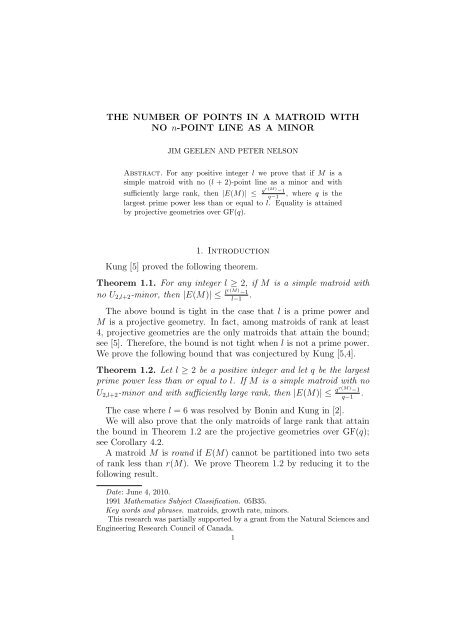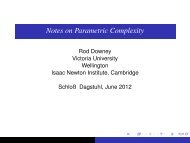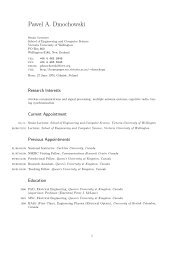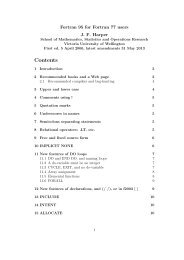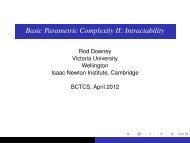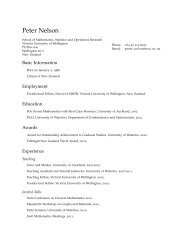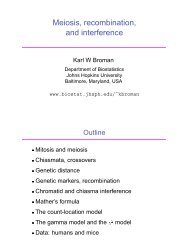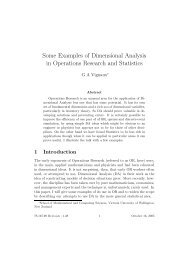The number of points in a matroid with no n-point line as a minor
The number of points in a matroid with no n-point line as a minor
The number of points in a matroid with no n-point line as a minor
You also want an ePaper? Increase the reach of your titles
YUMPU automatically turns print PDFs into web optimized ePapers that Google loves.
THE NUMBER OF POINTS IN A MATROID WITH<br />
NO n-POINT LINE AS A MINOR<br />
JIM GEELEN AND PETER NELSON<br />
Abstract. For any positive <strong>in</strong>teger l we prove that if M is a<br />
simple <strong>matroid</strong> <strong>with</strong> <strong>no</strong> (l + 2)-po<strong>in</strong>t l<strong>in</strong>e <strong>as</strong> a m<strong>in</strong>or and <strong>with</strong><br />
sufficiently large rank, then |E(M)| ≤ qr(M) −1<br />
q−1 , where q is the<br />
largest prime power less than or equal to l. Equality is atta<strong>in</strong>ed<br />
by projective geometries over GF(q).<br />
1. Introduction<br />
Kung [5] proved the follow<strong>in</strong>g theorem.<br />
<strong>The</strong>orem 1.1. For any <strong>in</strong>teger l ≥ 2, if M is a simple <strong>matroid</strong> <strong>with</strong><br />
<strong>no</strong> U2,l+2-m<strong>in</strong>or, then |E(M)| ≤ lr(M) −1<br />
l−1 .<br />
<strong>The</strong> above bound is tight <strong>in</strong> the c<strong>as</strong>e that l is a prime power and<br />
M is a projective geometry. In fact, among <strong>matroid</strong>s <strong>of</strong> rank at le<strong>as</strong>t<br />
4, projective geometries are the only <strong>matroid</strong>s that atta<strong>in</strong> the bound;<br />
see [5]. <strong>The</strong>refore, the bound is <strong>no</strong>t tight when l is <strong>no</strong>t a prime power.<br />
We prove the follow<strong>in</strong>g bound that w<strong>as</strong> conjectured by Kung [5,4].<br />
<strong>The</strong>orem 1.2. Let l ≥ 2 be a positive <strong>in</strong>teger and let q be the largest<br />
prime power less than or equal to l. If M is a simple <strong>matroid</strong> <strong>with</strong> <strong>no</strong><br />
U2,l+2-m<strong>in</strong>or and <strong>with</strong> sufficiently large rank, then |E(M)| ≤ qr(M) −1<br />
q−1 .<br />
<strong>The</strong> c<strong>as</strong>e where l = 6 w<strong>as</strong> resolved by Bon<strong>in</strong> and Kung <strong>in</strong> [2].<br />
We will also prove that the only <strong>matroid</strong>s <strong>of</strong> large rank that atta<strong>in</strong><br />
the bound <strong>in</strong> <strong>The</strong>orem 1.2 are the projective geometries over GF(q);<br />
see Corollary 4.2.<br />
A <strong>matroid</strong> M is round if E(M) can<strong>no</strong>t be partitioned <strong>in</strong>to two sets<br />
<strong>of</strong> rank less than r(M). We prove <strong>The</strong>orem 1.2 by reduc<strong>in</strong>g it to the<br />
follow<strong>in</strong>g result.<br />
Date: June 4, 2010.<br />
1991 Mathematics Subject Cl<strong>as</strong>sification. 05B35.<br />
Key words and phr<strong>as</strong>es. <strong>matroid</strong>s, growth rate, m<strong>in</strong>ors.<br />
This research w<strong>as</strong> partially supported by a grant from the Natural Sciences and<br />
Eng<strong>in</strong>eer<strong>in</strong>g Research Council <strong>of</strong> Canada.<br />
1
2 GEELEN AND NELSON<br />
<strong>The</strong>orem 1.3. For each prime power q, there exists a positive <strong>in</strong>teger n<br />
such that, if M is a round <strong>matroid</strong> <strong>with</strong> a PG(n − 1, q)-m<strong>in</strong>or but <strong>no</strong><br />
U 2,q 2 +1-m<strong>in</strong>or, then ɛ(M) ≤ qr(M) −1<br />
q−1 .<br />
For any <strong>in</strong>teger l ≥ 2, there is an <strong>in</strong>teger k such that 2 k−1 < l ≤ 2 k .<br />
<strong>The</strong>refore, if q is the largest prime power less than or equal to l, then<br />
l < 2q. So, to prove <strong>The</strong>orem 1.2, it would suffice to prove the weaker<br />
version <strong>of</strong> <strong>The</strong>orem 1.3 where U 2,q 2 +1 is replaced by U2,2q+1. With this<br />
<strong>in</strong> m<strong>in</strong>d, we f<strong>in</strong>d the stronger version somewhat surpris<strong>in</strong>g.<br />
We further reduce <strong>The</strong>orem 1.3 to the follow<strong>in</strong>g result.<br />
<strong>The</strong>orem 1.4. For each prime power q there exists an <strong>in</strong>teger n such<br />
that, if M is a round <strong>matroid</strong> that conta<strong>in</strong>s a U2,q+2-restriction and a<br />
PG(n − 1, q)-m<strong>in</strong>or, then M conta<strong>in</strong>s a U 2,q 2 +1-m<strong>in</strong>or.<br />
<strong>The</strong> follow<strong>in</strong>g conjecture, if true, would imply all <strong>of</strong> the results above.<br />
Conjecture 1.5. For each prime power q, there exists a positive <strong>in</strong>teger<br />
n such that, if M is a round <strong>matroid</strong> <strong>with</strong> a PG(n − 1, q)-m<strong>in</strong>or<br />
but <strong>no</strong> U 2,q 2 +1-m<strong>in</strong>or, then M is GF(q)-representable.<br />
<strong>The</strong> conjecture may hold <strong>with</strong> n = 3 for all q. Moreover, the<br />
conjecture may also hold when “round” is replaced by “vertically 4connected”.<br />
2. Prelim<strong>in</strong>aries<br />
We <strong>as</strong>sume that the reader is familiar <strong>with</strong> <strong>matroid</strong> theory; we use<br />
the <strong>no</strong>tation and term<strong>in</strong>ology <strong>of</strong> Oxley [6]. A rank-1 flat <strong>in</strong> a <strong>matroid</strong><br />
is referred to <strong>as</strong> a po<strong>in</strong>t and a rank-2 flat is a l<strong>in</strong>e. A l<strong>in</strong>e is long if it<br />
h<strong>as</strong> at le<strong>as</strong>t 3 <strong>po<strong>in</strong>ts</strong>. <strong>The</strong> <strong>number</strong> <strong>of</strong> <strong>po<strong>in</strong>ts</strong> <strong>in</strong> M is de<strong>no</strong>ted ɛ(M).<br />
Let M be a <strong>matroid</strong> and let A, B ⊆ E(M). We def<strong>in</strong>e ⊓M(A, B) =<br />
rM(A) + rM(B) − rM(A ∪ B); this is the local connectivity between<br />
A and B. This def<strong>in</strong>ition is motivated by geometry. Suppose that<br />
M is a restriction <strong>of</strong> PG(n − 1, q) and let FA and FB be the flats <strong>of</strong><br />
PG(n − 1, q) that are spanned by A and B respectively. <strong>The</strong>n FA ∩ FB<br />
h<strong>as</strong> rank ⊓M(A, B). We say that two sets A, B ⊆ E(M) are skew if<br />
⊓M(A, B) = 0.<br />
We let U(l) de<strong>no</strong>te the cl<strong>as</strong>s <strong>of</strong> <strong>matroid</strong>s <strong>with</strong> <strong>no</strong> U2,l+2-m<strong>in</strong>or. Our<br />
pro<strong>of</strong> <strong>of</strong> <strong>The</strong>orem 1.2 relies heavily on the follow<strong>in</strong>g result <strong>of</strong> Geelen<br />
and Kabell [3, <strong>The</strong>orem 2.1].<br />
<strong>The</strong>orem 2.1. <strong>The</strong>re is an <strong>in</strong>teger-valued function α(l, q, n) such that,<br />
for any positive <strong>in</strong>tegers l, q, n <strong>with</strong> l ≥ q ≥ 2, if M ∈ U(l) is a <strong>matroid</strong><br />
<strong>with</strong> ɛ(M) ≥ α(l, q, n)q r(M) , then M conta<strong>in</strong>s a PG(n−1, q ′ )-m<strong>in</strong>or for<br />
some prime-power q ′ > q.
MATROIDS WITH NO U2,n-MINOR 3<br />
<strong>The</strong> follow<strong>in</strong>g result is an important special c<strong>as</strong>e <strong>of</strong> <strong>The</strong>orem 1.4.<br />
Lemma 2.2. If M is a round <strong>matroid</strong> that conta<strong>in</strong>s a U2,q+2-restriction<br />
and a PG(2, q)-restriction, then M h<strong>as</strong> a U 2,q 2 +1-m<strong>in</strong>or.<br />
Pro<strong>of</strong>. Suppose that M is a m<strong>in</strong>imum-rank counterexample. Let<br />
L, P ⊆ E(M) such that M|L = U2,q+2 and M|P = PG(2, q). If M<br />
h<strong>as</strong> rank 3, then we may <strong>as</strong>sume that E(M) = P ∪ {e}. S<strong>in</strong>ce M|P is<br />
modular, e is <strong>in</strong> at most one long l<strong>in</strong>e <strong>of</strong> M. <strong>The</strong>n, s<strong>in</strong>ce |P | = q 2 +q+1,<br />
we have ɛ(M/e) ≥ q 2 + 1 and, hence, M h<strong>as</strong> a U 2,q 2 +1-m<strong>in</strong>or. This contradiction<br />
implies that r(M) > 3. S<strong>in</strong>ce M is round, there is an element<br />
e that is spanned by neither L <strong>no</strong>r P . Now M/e is round and conta<strong>in</strong>s<br />
both M|L and M|P <strong>as</strong> restrictions. This contradicts our choice <strong>of</strong><br />
M. <br />
<strong>The</strong> b<strong>as</strong>e c<strong>as</strong>e <strong>of</strong> the follow<strong>in</strong>g lemma is essentially proved <strong>in</strong><br />
[3, Lemma 2.4].<br />
Lemma 2.3. Let λ ∈ R. Let k and l ≥ q ≥ 2 be positive <strong>in</strong>tegers, and<br />
let A and B be disjo<strong>in</strong>t sets <strong>of</strong> elements <strong>in</strong> a <strong>matroid</strong> M ∈ U(l) <strong>with</strong><br />
⊓M(A, B) ≤ k and ɛM(A) > λq rM (A) . <strong>The</strong>n there is a set A ′ ⊆ A that<br />
is skew to B and satisfies ɛM(A ′ ) > λl −k q rM (A ′ ) .<br />
Pro<strong>of</strong>. By possibly contract<strong>in</strong>g some elements <strong>in</strong> B − clM(A), we may<br />
<strong>as</strong>sume that A spans B and thus that rM(B) = ⊓M(A, B). When<br />
k = 1, this means B h<strong>as</strong> rank 1. We resolve this b<strong>as</strong>e c<strong>as</strong>e first.<br />
Let e be a <strong>no</strong>n-loop element <strong>of</strong> B. We may <strong>as</strong>sume that A is m<strong>in</strong>imal<br />
<strong>with</strong> ɛM(A) > λq rM (A) , and that E(M) = A∪{e}. Let W be a flat <strong>of</strong> M<br />
<strong>no</strong>t conta<strong>in</strong><strong>in</strong>g e, such that rM(W ) = r(M)−2. Let H0, H1, . . . , Hm be<br />
the hyperplanes <strong>of</strong> M conta<strong>in</strong><strong>in</strong>g W , <strong>with</strong> e ∈ H0. <strong>The</strong> sets {Hi − W :<br />
1 ≤ i ≤ m} are a disjo<strong>in</strong>t cover <strong>of</strong> E(M) − W . Additionally, the<br />
<strong>matroid</strong> si(M/W ) is isomorphic to the l<strong>in</strong>e U2,m+1, so we k<strong>no</strong>w that<br />
m ≤ l.<br />
By the m<strong>in</strong>imality <strong>of</strong> A, we get ɛM(H0 ∩ A) ≤ λq r(M)−1 , so<br />
ɛM(A − H0) > λ(q − 1)q r(M)−1 .<br />
S<strong>in</strong>ce the hyperplanes H1, . . . , Hm cover E(M) − H0, a majority argument<br />
gives some 1 ≤ i ≤ m such that<br />
ɛM(Hi ∩ A) ≥ 1<br />
m ɛM(A − H0) > λ<br />
l (q − 1)qr(M)−1 .<br />
Sett<strong>in</strong>g A ′ = A ∩ Hi gives a set <strong>of</strong> the required <strong>number</strong> <strong>of</strong> <strong>po<strong>in</strong>ts</strong> that<br />
is skew to e and therefore to B, which is what we want.<br />
Now suppose that the result holds for k = t and consider the c<strong>as</strong>e<br />
that k = t + 1. Let A and B be disjo<strong>in</strong>t sets <strong>of</strong> elements <strong>in</strong> a <strong>matroid</strong>
4 GEELEN AND NELSON<br />
M <strong>with</strong> ⊓M(A, B) ≤ t + 1 and ɛM(A) > λq rM (A) . As mentioned earlier,<br />
we have rM(B) = ⊓M(A, B) ≤ t + 1. Let e be any <strong>no</strong>n-loop element<br />
<strong>of</strong> B. By the b<strong>as</strong>e c<strong>as</strong>e, there exists A ′ ⊆ A that is skew to {e} and<br />
satisfies ɛM(A ′ ) > λl −1 q rM (A ′ ) . S<strong>in</strong>ce e ∈ clM(A ′ ) and rM(B) ≤ t+1, we<br />
have ⊓M(A ′ , B) ≤ t. Now the result follows rout<strong>in</strong>ely by the <strong>in</strong>duction<br />
hypothesis. <br />
<strong>The</strong> follow<strong>in</strong>g two results are used <strong>in</strong> the reduction <strong>of</strong> <strong>The</strong>orem 1.2<br />
to <strong>The</strong>orem 1.3.<br />
Lemma 2.4. Let f(k) be an <strong>in</strong>teger-valued function such that f(k) ≥<br />
2f(k − 1) − 1 for each k ≥ 1 and f(1) ≥ 1. If M is a <strong>matroid</strong> <strong>with</strong><br />
ɛ(M) ≥ f(r(M)) and r(M) ≥ 1, then there is a round restriction N <strong>of</strong><br />
M such that ɛ(N) ≥ f(r(N)) and r(N) ≥ 1.<br />
Pro<strong>of</strong>. We may <strong>as</strong>sume that M is <strong>no</strong>t round and, hence, there is a<br />
partition (A, B) <strong>of</strong> E(M) such that rM(A) < r(M) and rM(B) < r(M).<br />
Clearly rM(A) ≥ 1 and rM(B) ≥ 1. Inductively we may <strong>as</strong>sume that<br />
ɛM(A) < f(rM(A)) and ɛM(B) < f(rM(B)). Thus ɛ(M) ≤ ɛ(M|A) +<br />
ɛ(M|B) ≤ f(rM(A)) + f(rM(B)) − 2 ≤ 2f(r(M) − 1) − 2 < f(r(M)),<br />
which is a contradiction. <br />
Lemma 2.5. Let q ≥ 4 and t ≥ 1 be <strong>in</strong>tegers and let M be a <strong>matroid</strong><br />
<strong>with</strong> ɛ(M) ≥ qr(M) −1<br />
and r(M) ≥ 3t. If M is <strong>no</strong>t round, then either M<br />
q−1<br />
h<strong>as</strong> a U2,q2 +2-m<strong>in</strong>or or there is a round restriction N <strong>of</strong> M such that<br />
r(N) ≥ t and ɛ(N) > qr(N) −1<br />
. q−1<br />
Pro<strong>of</strong>. Let s = r(M) and let f(k) = <br />
q s−k qk−1 . For any k ≥ 1,<br />
2 q−1<br />
<br />
q<br />
<br />
s−k−1 k+1 q − 1<br />
f(k + 1) =<br />
2 q − 1<br />
<br />
q<br />
<br />
s−k−1<br />
><br />
q<br />
2<br />
qk <br />
− 1<br />
q − 1<br />
= 2f(k).<br />
Moreover f(1) ≥ 1 and ɛ(M) ≥ f(r(M)). <strong>The</strong>n, by Lemma 2.4, there<br />
is a round restriction N <strong>of</strong> M such that r(N) ≥ 1 and ɛ(N) ≥ f(r(N)).<br />
S<strong>in</strong>ce M is <strong>no</strong>t round, r(N) < r(M) = s and, hence, ɛ(N) > qr(N) −1<br />
q−1 .
MATROIDS WITH NO U2,n-MINOR 5<br />
We may <strong>as</strong>sume that r(N) < t. <strong>The</strong>refore, s<strong>in</strong>ce s ≥ 3t and q ≥ 4,<br />
ɛ(N) ≥ f(r(N))<br />
<br />
q<br />
<br />
s−r(N) r(N) q − 1<br />
=<br />
2 q − 1<br />
<br />
q<br />
<br />
2t r(N) q − 1<br />
≥<br />
2 q − 1<br />
≥ q t<br />
<br />
r(N) q − 1<br />
q − 1<br />
> q r(N)<br />
<br />
r(N) q − 1<br />
q − 1<br />
<br />
r(N) r(N) q + 1 q − 1<br />
≥<br />
q + 1 q − 1<br />
2r(N) q − 1<br />
=<br />
q2 <br />
.<br />
− 1<br />
<strong>The</strong>refore, by <strong>The</strong>orem 1.1, M h<strong>as</strong> a U 2,q 2 +2-m<strong>in</strong>or, <strong>as</strong> required. <br />
3. <strong>The</strong> ma<strong>in</strong> results<br />
We start <strong>with</strong> a pro<strong>of</strong> <strong>of</strong> <strong>The</strong>orem 1.4, which we restate here.<br />
<strong>The</strong>orem 3.1. <strong>The</strong>re is an <strong>in</strong>teger-valued function n(q) such that, for<br />
each prime power q, if M is a round <strong>matroid</strong> that conta<strong>in</strong>s a U2,q+2restriction<br />
and a PG(n(q) − 1, q)-m<strong>in</strong>or, then M h<strong>as</strong> a U 2,q 2 +1-m<strong>in</strong>or.<br />
Pro<strong>of</strong>. Recall that the function α(l, q, n) w<strong>as</strong> def<strong>in</strong>ed <strong>in</strong> <strong>The</strong>orem 2.1.<br />
Let q be a prime power, let α = α(q2 − 1, q − 1, 3). Let n be an <strong>in</strong>teger<br />
that is sufficiently large so that<br />
q<br />
q−1<br />
n<br />
> αq 5 (q − 1) 2 . We def<strong>in</strong>e<br />
n(q) = n. Suppose that the result fails for this choice <strong>of</strong> n(q) and let<br />
M be a m<strong>in</strong>imum-rank counterexample. Thus M is a round <strong>matroid</strong><br />
hav<strong>in</strong>g a l<strong>in</strong>e L, <strong>with</strong> at le<strong>as</strong>t q + 2 <strong>po<strong>in</strong>ts</strong>, and a m<strong>in</strong>or N isomorphic<br />
to PG(n − 1, q), but M ∈ U(q 2 − 1).<br />
Suppose that N = M/C \ D where C is <strong>in</strong>dependent. If e ∈ C − L,<br />
then M/e is round, conta<strong>in</strong>s the l<strong>in</strong>e L, and h<strong>as</strong> N <strong>as</strong> m<strong>in</strong>or — contrary<br />
to our choice <strong>of</strong> M. <strong>The</strong>refore C ⊆ L and, hence, r(M) ≤ r(N) + 2 ≤<br />
n + 2.<br />
Let X = E(M) − L. By our choice <strong>of</strong> n, we have ɛ(M|(X − D)) ≥<br />
q n −1<br />
q−1 −(q2 +1) = q 3 qn−3 −1<br />
q−1 +q ≥ qn−1 > q 4 α(q−1) n+2 ≥ q 4 α(q−1) rM (X) .<br />
By Lemma 2.3, there is a flat F ⊆ X − D <strong>of</strong> M that is skew to L and<br />
satisfies ɛ(M|F ) ≥ α(q − 1) rM (F ) . S<strong>in</strong>ce F is skew to L, F is also skew
6 GEELEN AND NELSON<br />
to C. <strong>The</strong>refore M|F = N|F and hence M|F is GF(q)-representable.<br />
<strong>The</strong>n, by <strong>The</strong>orem 2.1, M|F h<strong>as</strong> a PG(2, q)-m<strong>in</strong>or. <strong>The</strong>refore there is<br />
a set Y ⊆ F such that (M|F )/Y conta<strong>in</strong>s a PG(2, q)-restriction. Now<br />
M/Y is round, conta<strong>in</strong>s a (q + 2)-po<strong>in</strong>t l<strong>in</strong>e, and conta<strong>in</strong>s a PG(2, q)restriction.<br />
<strong>The</strong>n, by Lemma 2.2, M h<strong>as</strong> a U 2,q 2 +1-m<strong>in</strong>or. <br />
Now we will prove <strong>The</strong>orem 1.3 which we reformulate here. <strong>The</strong><br />
function n(q) w<strong>as</strong> def<strong>in</strong>ed <strong>in</strong> <strong>The</strong>orem 3.1.<br />
<strong>The</strong>orem 3.2. For each prime power q, if M is a round <strong>matroid</strong> <strong>with</strong><br />
a PG(n(q) − 1, q)-m<strong>in</strong>or but <strong>no</strong> U 2,q 2 +1-m<strong>in</strong>or, then ɛ(M) ≤ qr(M) −1<br />
q−1 .<br />
Pro<strong>of</strong>. Let M be a m<strong>in</strong>imum-rank counterexample. By Lemma 2.2,<br />
r(M) > n(q). Let e ∈ E(M) be a <strong>no</strong>n-loop element such that M/e<br />
h<strong>as</strong> a PG(n − 1, q)-m<strong>in</strong>or. Note that M/e is round. <strong>The</strong>n, by the<br />
. By <strong>The</strong>orem 3.1, each l<strong>in</strong>e <strong>of</strong> M<br />
conta<strong>in</strong><strong>in</strong>g e h<strong>as</strong> at most q + 1 <strong>po<strong>in</strong>ts</strong>. Hence ɛ(M) ≤ 1 + qɛ(M/e) ≤<br />
qr(M)−1 −1<br />
1+q<br />
= q−1<br />
qr(M) −1<br />
. This contradiction completes the pro<strong>of</strong>. <br />
q−1<br />
m<strong>in</strong>imality <strong>of</strong> M, ɛ(M/e) ≤ qr(M)−1 −1<br />
q−1<br />
We can <strong>no</strong>w prove our ma<strong>in</strong> result, <strong>The</strong>orem 1.2, which we restate<br />
below.<br />
<strong>The</strong>orem 3.3. Let l ≥ 2 be a positive <strong>in</strong>teger and let q be the largest<br />
prime power less than or equal to l. If M is a <strong>matroid</strong> <strong>with</strong> <strong>no</strong> U2,l+2m<strong>in</strong>or<br />
and <strong>with</strong> sufficiently large rank, then ɛ(M) ≤ qr(M) −1<br />
q−1 .<br />
Pro<strong>of</strong> <strong>of</strong> <strong>The</strong>orem 1.2. When l is a prime-power, the result follows from<br />
<strong>The</strong>orem 1.1. <strong>The</strong>refore we may <strong>as</strong>sume that l ≥ 6 and, hence, q ≥ 5.<br />
Recall that n(q) is def<strong>in</strong>ed <strong>in</strong> <strong>The</strong>orem 3.1 and α(l, q − 1, n) is def<strong>in</strong>ed<br />
<strong>in</strong> <strong>The</strong>orem 2.1. Let n = n(q) and let k be an <strong>in</strong>teger that is sufficiently<br />
large so that<br />
k q<br />
q−1<br />
≥ qα(l, q − 1, n). Thus, for any k ′ ≥ k, we get<br />
qk′ −1<br />
q−1 ≥ qk′ −1 k ≥ α(l, q − 1, n)(q − 1) ′<br />
. Let M ∈ U(l) be a <strong>matroid</strong> <strong>of</strong><br />
rank at le<strong>as</strong>t 3k such that ɛ(M) > qr(M) −1<br />
. By Lemma 2.5, M h<strong>as</strong> a<br />
q−1<br />
round restriction N such that we have r(N) ≥ k and ɛ(N) > qr(N) −1<br />
q−1<br />
α(l, q−1, n)(q−1) r(N) . By <strong>The</strong>orem 2.1, N h<strong>as</strong> a PG(n(q)−1, q ′ )-m<strong>in</strong>or<br />
for some q ′ > q − 1. If q ′ > q, then q ′ + 1 ≥ l + 2, so this projective<br />
geometry h<strong>as</strong> a U2,l+2-m<strong>in</strong>or, contradict<strong>in</strong>g our hypothesis. We may<br />
therefore conclude that q ′ = q, so N h<strong>as</strong> a PG(n(q) − 1, q)-m<strong>in</strong>or. Now<br />
we get a contradiction by <strong>The</strong>orem 3.2. <br />
≥
MATROIDS WITH NO U2,n-MINOR 7<br />
4. Extremal Matroids<br />
In this section, we prove that the extremal <strong>matroid</strong>s <strong>of</strong> large rank for<br />
<strong>The</strong>orem 1.2 are projective geometries. We need the follow<strong>in</strong>g result<br />
to recognize projective geometries; see Oxley [6, <strong>The</strong>orem 6.1.1].<br />
Lemma 4.1. Let M be a simple <strong>matroid</strong> <strong>of</strong> rank n ≥ 4 such that every<br />
l<strong>in</strong>e <strong>of</strong> M conta<strong>in</strong>s at le<strong>as</strong>t three <strong>po<strong>in</strong>ts</strong> and each pair <strong>of</strong> disjo<strong>in</strong>t l<strong>in</strong>es<br />
<strong>of</strong> M is skew. <strong>The</strong>n M is isomorphic to PG(n − 1, q) for some prime<br />
power q.<br />
We can <strong>no</strong>w prove our extremal characterization.<br />
Corollary 4.2. Let l ≥ 2 be a positive <strong>in</strong>teger and let q be the largest<br />
prime power less than or equal to l. If M is a simple <strong>matroid</strong> <strong>with</strong><br />
<strong>no</strong> U2,l+2-m<strong>in</strong>or, <strong>with</strong> ɛ(M) = qr(M) −1<br />
q−1 , and <strong>with</strong> sufficiently large rank,<br />
then M is a projective geometry over GF(q).<br />
Pro<strong>of</strong>. Kung [5] proved the result for the c<strong>as</strong>e that l is a prime-power.<br />
<strong>The</strong>refore we may <strong>as</strong>sume that l ≥ 6 and, hence, q ≥ 5. By <strong>The</strong>orem<br />
1.2, there is an <strong>in</strong>teger k1 such that, if M is a <strong>matroid</strong> <strong>with</strong> <strong>no</strong><br />
U2,l+2-m<strong>in</strong>or and <strong>with</strong> r(M) ≥ k1, then ɛ(M) ≤ qr(M) −1<br />
q−1 . Recall that<br />
n(q) is def<strong>in</strong>ed <strong>in</strong> <strong>The</strong>orem 3.1 and α(l, q, n) is def<strong>in</strong>ed <strong>in</strong> <strong>The</strong>orem 2.1.<br />
Let k2 be large e<strong>no</strong>ugh so that<br />
k = max(k1, k2).<br />
k2 q<br />
q−1 ≥ qα(l, q − 1, n(q) + 2), and<br />
Let M ∈ U(l) be a simple <strong>matroid</strong> <strong>of</strong> rank at le<strong>as</strong>t 3k such that<br />
ɛ(M) = qr(M) −1<br />
. If M is <strong>no</strong>t round, then, by Lemma 2.5, M h<strong>as</strong> a<br />
q−1<br />
round restriction N such that r(N) ≥ k and ɛ(N) > qr(N) −1<br />
, contrary<br />
q−1<br />
to <strong>The</strong>orem 1.2. Hence M is round.<br />
From the def<strong>in</strong>ition <strong>of</strong> k2, we get ɛ(M) ≥ α(l, q−1, n(q)+2)(q−1) r(M) ,<br />
so by <strong>The</strong>orem 2.1, M h<strong>as</strong> a PG(n(q) + 1, q)-m<strong>in</strong>or. <strong>The</strong>refore, by<br />
<strong>The</strong>orem 3.1, each l<strong>in</strong>e <strong>in</strong> M h<strong>as</strong> at most q + 1 <strong>po<strong>in</strong>ts</strong>. Consider any<br />
. <strong>The</strong>n<br />
element e ∈ E(M). By <strong>The</strong>orem 1.2, ɛ(M/e) ≤ qr(M)−1 −1<br />
q−1<br />
ɛ(M) ≤ 1 + qɛ(M/e)<br />
<br />
r(M)−1 q − 1<br />
≤ 1 + q<br />
q − 1<br />
= qr(M) − 1<br />
q − 1<br />
= ɛ(M).<br />
<strong>The</strong> <strong>in</strong>equalities above must hold <strong>with</strong> equality. <strong>The</strong>refore each l<strong>in</strong>e <strong>in</strong><br />
M h<strong>as</strong> exactly q + 1 <strong>po<strong>in</strong>ts</strong>.
8 GEELEN AND NELSON<br />
If M is <strong>no</strong>t a projective geometry, then, by Lemma 4.1, there are two<br />
disjo<strong>in</strong>t l<strong>in</strong>es L1 and L2 <strong>in</strong> M such that ⊓M(L1, L2) = 1. Let e ∈ L1.<br />
<strong>The</strong>n L2 spans a l<strong>in</strong>e <strong>with</strong> at le<strong>as</strong>t q + 2 <strong>po<strong>in</strong>ts</strong> <strong>in</strong> M/e. S<strong>in</strong>ce M h<strong>as</strong> a<br />
PG(n(q) + 1, q)-m<strong>in</strong>or, M/e conta<strong>in</strong>s a PG(n(q) − 1, q)-m<strong>in</strong>or; see [1,<br />
Lemma 5.2]. This contradicts <strong>The</strong>orem 3.1. <br />
Ack<strong>no</strong>wledgements<br />
We thank the referees for their careful read<strong>in</strong>g <strong>of</strong> the manuscript and<br />
for their useful comments.<br />
References<br />
[1] J. Geelen, B. Gerards, G. Whittle, On Rota’s conjecture and excluded<br />
m<strong>in</strong>ors conta<strong>in</strong><strong>in</strong>g large projective geometries, J. Comb<strong>in</strong>.<br />
<strong>The</strong>ory Ser. B 96 (2006), 405-425.<br />
[2] J.E. Bon<strong>in</strong>, J.P.S. Kung, <strong>The</strong> <strong>number</strong> <strong>of</strong> <strong>po<strong>in</strong>ts</strong> <strong>in</strong> a comb<strong>in</strong>atorial<br />
geometry <strong>with</strong> <strong>no</strong> 8-po<strong>in</strong>t-l<strong>in</strong>e m<strong>in</strong>ors, Mathematical essays<br />
<strong>in</strong> ho<strong>no</strong>r <strong>of</strong> Gian-Carlo Rota, Cambridge, MA (1996), 271-284,<br />
Progr. Math., 161, Birkhäuser Boston, Boston, MA, (1998).<br />
[3] J. Geelen, K. Kabell, Projective geometries <strong>in</strong> dense <strong>matroid</strong>s, J.<br />
Comb<strong>in</strong>. <strong>The</strong>ory Ser. B 99 (2009), 1-8.<br />
[4] J. Geelen, J.P.S. Kung, G. Whittle, Growth rates <strong>of</strong> m<strong>in</strong>or-closed<br />
cl<strong>as</strong>ses <strong>of</strong> <strong>matroid</strong>s, J. Comb<strong>in</strong>. <strong>The</strong>ory Ser. B 99 (2009), 420-427.<br />
[5] J.P.S. Kung, Extremal <strong>matroid</strong> theory, <strong>in</strong>: Graph Structure <strong>The</strong>ory<br />
(Seattle WA, 1991), Contemporary Mathematics, 147, American<br />
Mathematical Society, Providence RI, 1993, pp. 21–61.<br />
[6] J. G. Oxley, Matroid <strong>The</strong>ory, Oxford University Press, New York,<br />
1992.<br />
Department <strong>of</strong> Comb<strong>in</strong>atorics and Optimization, University <strong>of</strong> Waterloo,<br />
Waterloo, Canada


